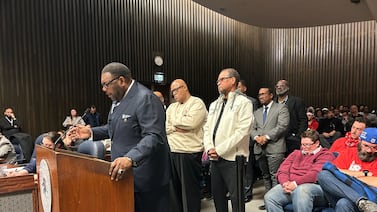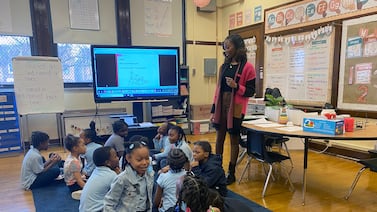Sign up for Chalkbeat’s free weekly newsletter to keep up with how education is changing across the U.S.
From poor reading skills to chaotic classrooms, the stubbornly high rate at which kids are absent from school makes it harder to solve every other problem in education. That’s made improving attendance a rare point of bipartisan agreement.
A new coalition announced a campaign on Wednesday calling on schools to cut their chronic absenteeism rates in half from the 2021-22 school year, when rates peaked across the country, by the 2026-27 school year.
The goal is to reverse what happened during the pandemic, when the share of kids who miss a lot of school nearly doubled.
As part of the new campaign, the coalition plans to highlight examples of states and school districts that have successfully tackled absenteeism challenges.
While many schools have worked to curb chronic absenteeism — typically defined as when kids miss 10% or more of their school year, or around 18 days — the problem has persisted and is pervasive. Setting aggressive goals and making concrete plans to achieve them is the only way to turn that around, the coalition said.
It could also be the key to addressing pandemic learning loss.
Kids of different achievement levels, of every race, in every state, in every kind of community, have had higher rates of absenteeism in recent years — whether their schools closed for a long time or not.
“That kind of churn just makes everything more difficult,” said Hedy Chang, the executive director of Attendance Works, referring to everything from establishing classroom routines to keeping lesson plans on track. “For me, that actually fuels the urgency of this issue.”
The trio leading the coalition — which held a Washington, D.C. event where Chang and others kicked off the campaign — is an unlikely one. It’s made up of the American Enterprise Institute, a conservative think tank; The Education Trust, a leading civil rights group; and Attendance Works, a nonprofit with a long history of working on absenteeism issues.
“This is the real threat that we’re looking at now: That chronic absenteeism doesn’t go back down, that it becomes a new normal,” said Nat Malkus, the deputy director of education policy at the American Enterprise Institute. “It is a big deal, and we’re going to need concerted effort to counter it.”
Denise Forte, who heads The Education Trust, said the idea to join forces came to her after she and Malkus voiced similar concerns about student absenteeism to the U.S. House Committee on Oversight and Accountability in January.
“I thought to myself: This is a unique opportunity with two organizations and two people that don’t always think alike on many things, but on this one we could come together,” Forte said.
Virginia and Rhode Island education officials who joined the event said their states had seen close links between who was chronically absent and who was struggling in school.
Lisa Coons, Virginia’s superintendent of public instruction, said when her staff combed through state test score data last year to understand why they weren’t seeing more learning loss recovery, one consistent factor stood out. In grades 3-8, if a student was chronically absent, they scored 18% lower in reading on average, and 25% lower in mathematics.
“Kiddos don’t know the work, they don’t want to come to school, they feel like they’re behind, so they get further behind,” Coons said. “We have to break that cycle.”
Schools across the country have tried launching new attendance-tracking systems, hiring people to knock on family’s doors, and giving away prizes to help re-engage students. And while many states have reduced their chronic absenteeism rates recently, they generally remain higher than before the pandemic.
Ongoing work to reduce chronic absenteeism will look different across the country, Chang said, especially as the COVID relief dollars that many school districts had relied on to pay for their attendance campaigns dry up at the start of the new school year.
“The challenge of chronic absence is there are multiple issues and reasons that cause kids to be chronically absent,” she said. “You have to use your local understanding from kids, families, and your data to really figure out what’s going to make the biggest difference in your community.”
The coalition highlighted the work happening in Rhode Island, which brought down its chronic absenteeism rate by 5 percentage points during the 2022-23 school year. There, state officials put up “We miss you” billboards to catch students’ attention, and assembled a public dashboard that tracks the daily attendance rate for schools across the state.
Officials use it to monitor how attendance is going in middle schools, in high schools, for kids who’ve been chronically absent for three years, and for kids who started to be absent a lot when they were young, said Angélica Infante-Green, the state’s education commissioner.
A parent working group helps inform the state’s attendance initiatives, whether that’s figuring out which bodegas and laundromats should hang information flyers, or recommending trusted community members who can knock on families’ doors.
“This is everyone’s responsibility,” she said.
Kalyn Belsha is a senior national education reporter based in Chicago. Contact her at kbelsha@chalkbeat.org.




